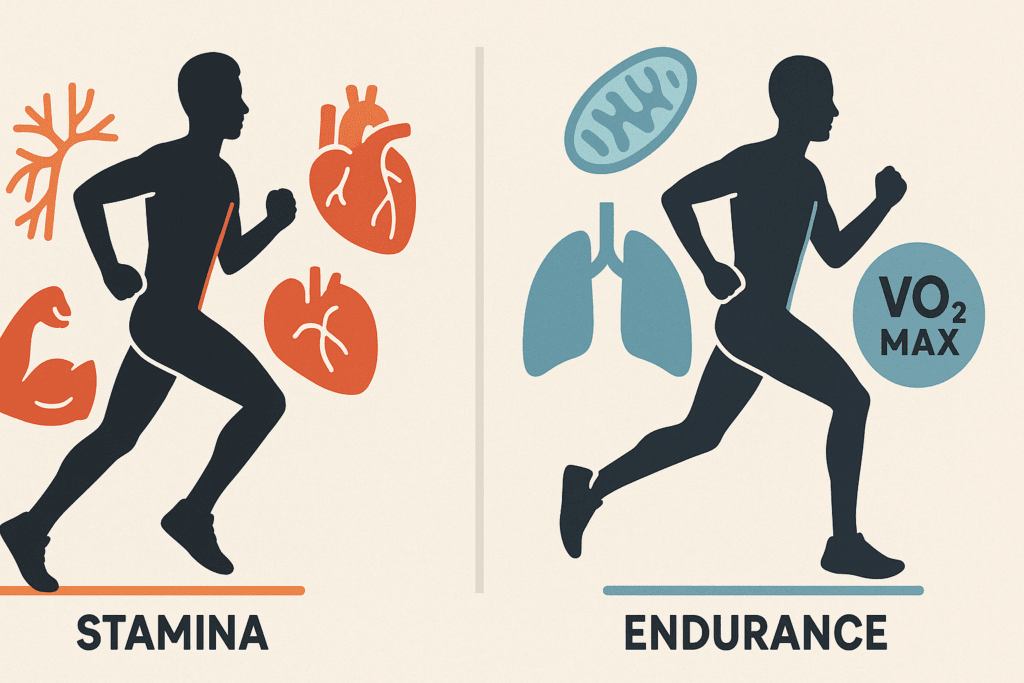Introduction: Why Building Running Stamina Matters More Than You Think
For many runners, especially those just beginning or returning after a break, one of the most persistent challenges is learning how to build stamina fast for running. Endurance is not just about lasting longer on the track or trail; it’s about pushing past previous limitations, enhancing cardiovascular health, and unlocking new performance levels. While running is a natural human movement, developing sustained running stamina takes intentional effort, smart training, and a deep understanding of the body’s energy systems. Understanding how to increase stamina for running requires a strategic balance of physiological training, mental conditioning, and adequate recovery.
The pursuit of gaining running stamina is often more than a physical endeavor; it’s also an exercise in discipline, patience, and resilience. Whether you’re preparing for a race, improving your health, or simply seeking a new challenge, knowing how to improve running endurance can help you progress with confidence. This guide offers a comprehensive, evidence-based approach for those looking to increase their endurance through practical, natural methods. If you’ve ever asked, “How can I increase my endurance for running?” or wondered about the best way to build stamina running without risking injury, you’re not alone—and you’re in the right place.
You may also like: How to Increase Stamina and Endurance Naturally: Smart Training Tips and Nutrition Habits That Support Cardiovascular Fitness

Understanding the Science Behind Stamina and Endurance
Before diving into the most effective exercises to increase stamina, it’s important to understand what stamina and endurance really mean. While often used interchangeably, they represent distinct aspects of physical fitness. Stamina generally refers to the ability to sustain prolonged physical or mental effort, whereas endurance specifically describes the body’s ability to maintain prolonged aerobic activity. In the context of running, both are essential and interdependent.
Developing running stamina means training the cardiovascular system to efficiently deliver oxygen to working muscles, while simultaneously teaching the muscles to use that oxygen effectively. This involves increasing mitochondrial density, improving VO2 max, and enhancing lactate threshold levels. Learning how to build stamina and endurance for running means taking a holistic view of training, incorporating aerobic base-building with high-intensity conditioning, proper nutrition, and sleep.
The best way to increase running stamina is to engage multiple body systems in a coordinated manner. The heart, lungs, muscles, and brain all play critical roles in sustaining performance. By understanding how to develop stamina for running from a physiological perspective, athletes and enthusiasts alike can make informed decisions that accelerate progress while minimizing the risk of overtraining or burnout.

Foundations First: Aerobic Base Building for Long-Term Stamina
Building an aerobic base is the foundation for any effective running stamina workout. This phase focuses on slow to moderate-paced running that allows your heart rate to remain in Zone 2 (typically around 60-70% of your max heart rate). While this may feel slow, it is essential for improving capillary density and teaching the body to burn fat more efficiently as fuel. The goal during this phase is not speed, but sustainability.
If you’re wondering how to gain stamina effectively, especially as a beginner, the answer lies in consistency and patience. Regular, low-intensity runs over weeks or months will expand your aerobic capacity, making higher-intensity workouts more effective later on. These runs should be conversational in pace—if you can hold a conversation while running, you’re likely in the right zone.
For beginners and experienced runners alike, aerobic base training serves as the groundwork upon which speed and power can be built. It’s one of the most reliable methods to increase stamina and to prepare the body for more rigorous demands. So we can work on your stamina in a way that ensures long-term progress, not just short-term gains, building your aerobic foundation is an essential first step.

Tempo Runs and Threshold Training: Pushing the Lactate Limit
Once a strong aerobic base has been developed, incorporating tempo runs and threshold workouts is a powerful way to boost endurance. These workouts typically involve sustained efforts at 80-90% of your maximum heart rate, where you begin to accumulate lactate but can still clear it effectively. This type of training helps your body adapt to running at faster paces for longer periods.
Tempo running is key to learning how to improve running endurance without overexerting the body. A classic tempo run might involve a 10- to 20-minute warm-up, followed by 20 minutes of comfortably hard running, then a cool-down. These sessions teach your body how to run efficiently at a higher effort level, a vital component in gaining running stamina.
Threshold training, often referred to as running at your “lactate threshold,” helps delay the point at which fatigue sets in. This is one of the best ways to increase stamina, as it enables you to sustain faster paces over time. Learning how to build stamina fast for running doesn’t mean skipping steps—it means training smarter and understanding how various systems respond to specific stimuli.
Interval Workouts: The Speed-Endurance Connection
Interval training is often associated with speed work, but it also plays a crucial role in building endurance. These high-intensity workouts involve alternating bursts of fast running with periods of active recovery. For example, running 400 meters at a fast pace followed by 200 meters of jogging, repeated multiple times.
The key to using intervals as an effective running stamina workout is in managing the intensity and recovery. By stressing the anaerobic and aerobic systems in short bursts, interval training stimulates cardiovascular improvements and muscular adaptations that directly translate to better endurance. This is especially effective for those asking how to get better endurance for running in a shorter period.
One of the best ways to build stamina running, particularly for those pressed for time, is to include intervals once or twice a week. This method not only boosts performance but also breaks the monotony of long runs. As with any workout, proper form, pacing, and recovery are crucial to avoid injury and ensure progress.

Fartlek Training: Freedom and Flexibility in Endurance Building
Fartlek, a Swedish term meaning “speed play,” is a training method that combines steady-state running with bursts of speed. Unlike structured intervals, fartlek runs are more intuitive, allowing runners to vary pace based on how they feel. For instance, you might jog for five minutes, sprint for one, run at a moderate pace for three, and repeat in varying sequences.
This unstructured format makes fartlek training a fun and effective way to improve endurance. It helps answer the common question: how can I gain stamina while keeping training enjoyable? The freedom to adjust intensity makes this method suitable for runners of all levels.
Integrating fartlek workouts into your weekly plan provides a dynamic approach to gaining running stamina. It keeps your body guessing and enhances both aerobic and anaerobic systems, making it a versatile method in the broader strategy of how to build stamina to run farther and faster.
Hill Repeats: Strength Meets Stamina
Running uphill builds muscular strength, cardiovascular fitness, and mental toughness. Incorporating hill repeats into your training program is one of the most powerful exercises to improve running endurance. Hills force your body to work against gravity, increasing the demand on your quads, hamstrings, and glutes—all essential muscles for strong, efficient running.
Typically, a hill repeat session includes running hard up a hill for 30 to 60 seconds, then jogging or walking down for recovery. This not only builds strength but also mimics the physiological stress of racing. The best way to increase running stamina is often found in these tough yet rewarding sessions that challenge both the body and the mind.
Hill training improves running economy, meaning your body uses less energy at a given pace. This is crucial when learning how to develop stamina for running, especially for events like trail runs or races with elevation changes. Incorporating hills once a week can yield significant improvements in both strength and stamina.
Cross-Training and Active Recovery: Building Stamina Beyond Running
While running-specific workouts are vital, cross-training is an often-overlooked component of building endurance. Activities such as swimming, cycling, rowing, and elliptical training provide cardiovascular benefits without the joint stress associated with running. These methods are especially helpful for increasing running endurance for beginners who may not yet tolerate high-impact training.
Cross-training enhances overall fitness while giving the muscles and joints a break from repetitive stress. When strategically included, these sessions can contribute to how to gain more stamina without risking overuse injuries. It’s also an effective way to stay active during rest days or recovery periods while maintaining cardiovascular conditioning.
Similarly, active recovery—light movement on rest days—promotes blood flow and muscle repair. Gentle yoga, walking, or swimming can facilitate recovery while keeping you on track with your stamina goals. The best way to get stamina isn’t always about pushing harder; it’s often about training smarter and respecting the body’s need for balance.

Fueling and Hydration: Nutrition Strategies for Endurance Performance
No discussion on how to improve my stamina for running would be complete without addressing nutrition. The body’s ability to sustain long efforts is deeply influenced by what you eat and drink. Carbohydrates, fats, and proteins all play essential roles in fueling endurance exercise. Consuming complex carbs like oats, brown rice, and sweet potatoes supports glycogen stores, which are the primary fuel source during aerobic efforts.
Hydration is equally critical. Dehydration reduces blood volume, impairs thermoregulation, and can significantly hinder performance. Electrolyte balance also plays a key role in muscle function and endurance. Knowing how to raise stamina through proper nutrition means paying attention to both macro- and micronutrient intake.
Post-run recovery meals should include protein to support muscle repair and carbs to replenish glycogen. Incorporating real, whole foods rather than relying solely on processed supplements ensures better long-term health and performance. For those seeking ways to build stamina and improve endurance naturally, nutrition and hydration strategies are just as vital as physical training.

Mental Toughness: The Psychological Edge in Endurance Training
Running long distances requires not just physical strength but also mental resilience. Learning how to get stamina involves training the mind as much as the body. Visualization, self-talk, and mindfulness can all help runners push through mental fatigue and stay motivated during challenging sessions.
Mental fatigue often sets in before physical limits are reached. Training yourself to embrace discomfort, stay focused, and break tasks into manageable segments can drastically improve endurance. Techniques like repeating mantras or focusing on breath can anchor the mind and prevent negative thinking.
Understanding that endurance is a skill that includes emotional regulation and cognitive focus can be a game-changer. The best way to increase stamina often comes down to how well you can manage the conversation in your head when the going gets tough. Developing mental tools is an essential part of any effective running stamina workout.
Frequently Asked Questions: Building Running Stamina and Endurance
1. How long does it typically take to notice improvements in running stamina?
While each individual’s progress varies depending on genetics, baseline fitness, and training intensity, most people begin to see measurable gains in running stamina within three to six weeks of consistent effort. The key lies in a progressive overload approach—gradually increasing distance, time, or intensity without overwhelming the body. If you’re following a well-structured running stamina workout that includes both aerobic base-building and targeted interval work, your body will start adapting within this window. Recovery and nutrition also play essential roles in how quickly your endurance builds, as they directly affect muscle repair and energy storage. Consistency across all pillars—exercise, rest, and fuel—determines how to gain stamina most efficiently over time.
2. Can strength training help me build stamina and endurance for running?
Absolutely. While many runners overlook strength training in favor of logging more miles, it plays a crucial role in injury prevention and muscular efficiency. Stronger muscles reduce fatigue and improve running economy, making each stride more effective. For those wondering how to build stamina and endurance for running, compound lifts like squats, deadlifts, and lunges provide functional strength that translates directly into better performance. Integrating resistance training 2-3 times per week alongside your running program is one of the most underrated methods to increase stamina. It also fortifies the joints and connective tissues, supporting longevity in your training journey.
3. What role does sleep play in building running stamina fast?
Sleep is where your body does the majority of its repair work, especially after intense workouts aimed at improving endurance. Inadequate sleep interferes with hormone regulation, immune function, and muscle recovery—all of which are critical to gaining running stamina. Deep sleep promotes the release of growth hormone, which facilitates muscle repair and adaptation. If you’re searching for how to build stamina fast for running, quality sleep should be a top priority alongside physical training. Aim for at least 7-9 hours per night, and avoid training hard after poor rest days to prevent injury and overtraining.
4. Are there psychological techniques that support stamina development?
Yes, psychological strategies like visualization, mindfulness, and cognitive reframing significantly enhance endurance capacity. Learning how to gain more stamina often involves pushing past perceived limits, which are more mental than physical. Techniques such as breaking your run into manageable chunks or repeating affirmations during tough intervals can help keep you mentally engaged. Practicing mindfulness while running allows you to monitor your breath and sensations more effectively, keeping fatigue at bay. So we can work on your stamina from both physical and mental angles, incorporating cognitive tools is just as important as physical conditioning.
5. How can I adapt my training to improve running endurance in hot or humid climates?
Training in high heat or humidity adds an extra layer of cardiovascular strain, which can either boost your fitness or derail it, depending on how you manage the stress. The best way to increase running stamina in these conditions is by gradually acclimating over 10-14 days, starting with shorter, slower runs. Hydration becomes even more critical, and electrolyte intake should be adjusted to match your sweat rate. You may also benefit from early morning or late evening runs when temperatures are lower. Wearing breathable clothing and monitoring perceived exertion rather than pace can help you tailor your workouts safely, especially when aiming to get better endurance for running in tough environmental conditions.
6. What’s the best way to build stamina running during a busy work schedule?
For time-pressed individuals, short but strategic workouts can be highly effective. High-Intensity Interval Training (HIIT) and tempo sessions offer efficient ways to trigger endurance adaptations without the need for long runs. Knowing how to get stamina when your schedule is limited means prioritizing workout quality over quantity. Running on your commute (if feasible), incorporating treadmill intervals during lunch, or using weekends for long runs can make a major difference. Consistency is the best way to get stamina—even 20 minutes a day of purposeful training can yield results when done consistently over time.
7. Is there a difference in training methods for beginners vs. advanced runners looking to increase stamina?
Yes, training programs should reflect your current fitness level, goals, and previous running experience. Beginners should emphasize gradual volume increases and low-to-moderate intensity sessions to build a solid aerobic base. The best way to increase running stamina for beginners often involves run-walk strategies and cross-training to avoid injury. Advanced runners, on the other hand, can focus more on lactate threshold workouts, hill repeats, and specific race-pace efforts. Knowing how to develop stamina for running at different stages of your journey allows you to avoid plateaus and continue progressing safely.
8. Can breathing techniques impact my running stamina and endurance?
Breathing is often an overlooked component of endurance development, yet it significantly influences oxygen delivery and perceived effort. Diaphragmatic breathing, or belly breathing, maximizes lung capacity and helps reduce anxiety during intense runs. Practicing rhythmic breathing—synchronizing your breath with your footstrike—can also help balance your effort and reduce the risk of side stitches. These methods to increase stamina are especially useful during tempo and interval runs where controlled breathing sustains performance. By improving your respiratory efficiency, you support how to improve my stamina for running without adding physical strain.
9. Are supplements necessary to support stamina gains for runners?
While whole foods should always form the foundation of your nutrition strategy, certain supplements can support endurance under specific circumstances. Beetroot juice, for example, has been shown to improve blood flow and oxygen uptake, enhancing running performance in time trials. Adaptogens like Rhodiola rosea may also help reduce perceived exertion and speed recovery. However, supplements are never a substitute for consistent training and proper diet—they can only enhance a solid base. When considering how can I gain stamina naturally, it’s always best to consult with a sports nutritionist before introducing any ergogenic aids.
10. What are some overlooked exercises to improve running endurance?
Many runners don’t realize that exercises outside of running can dramatically influence performance. Jump rope drills, agility ladders, and mobility-focused yoga sessions all contribute to enhanced coordination, foot turnover, and recovery. Plyometric exercises, in particular, improve neuromuscular efficiency and explosive strength, which translate into more powerful strides. These cross-disciplinary exercises to improve running endurance not only break training monotony but also reduce injury risk. Exploring diverse ways to build stamina can reveal new performance pathways and prevent burnout while keeping training both productive and enjoyable.
Conclusion: Training Smarter to Build Running Stamina Fast and Sustainably
Improving running endurance is a multifaceted process that goes beyond simply running more miles. From aerobic base-building and tempo runs to interval sessions and hill repeats, each training component plays a unique role in the journey of gaining running stamina. Understanding how to build stamina fast for running involves not just hard work, but also smart, evidence-based strategies that balance intensity with recovery, and strength with sustainability.
For those who wonder how to improve their stamina for running or are searching for the best way to increase stamina, the answers lie in a comprehensive, personalized approach. It’s not about quick fixes, but consistent effort and deliberate progress. Whether you’re just starting or refining your training for competitive performance, embracing varied methods and listening to your body ensures long-term growth.
With the right blend of exercise, nutrition, recovery, and mindset, you can achieve the stamina goals you once thought were out of reach. So we can work on your stamina in a way that aligns with your unique strengths and needs, take the next step with confidence and determination. Your journey toward better endurance and peak performance starts now.
Was this article helpful? Don’t let it stop with you. Share it right now with someone who needs to see it—whether it’s a friend, a colleague, or your whole network. And if staying ahead on this topic matters to you, subscribe to this publication for the most up-to-date information. You’ll get the latest insights delivered straight to you—no searching, no missing out.
Further Reading:
What’s the Difference Between Endurance and Stamina?

